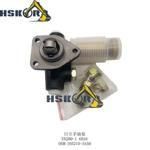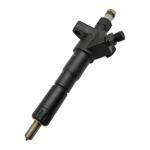Information injection-pump assembly
BOSCH
9 400 613 329
9400613329
ZEXEL
101608-6460
1016086460
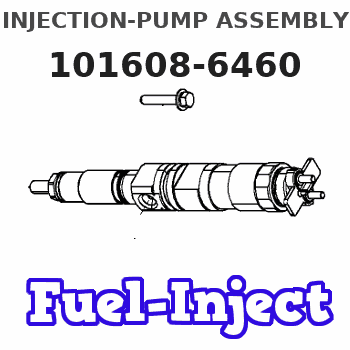
Rating:
Service parts 101608-6460 INJECTION-PUMP ASSEMBLY:
1.
_
7.
COUPLING PLATE
8.
_
9.
_
11.
Nozzle and Holder
ME441294
12.
Open Pre:MPa(Kqf/cm2)
17.7{180}
15.
NOZZLE SET
Include in #1:
101608-6460
as INJECTION-PUMP ASSEMBLY
Include in #2:
104749-0636
as _
Cross reference number
BOSCH
9 400 613 329
9400613329
ZEXEL
101608-6460
1016086460
Zexel num
Bosch num
Firm num
Name
Calibration Data:
Adjustment conditions
Test oil
1404 Test oil ISO4113 or {SAEJ967d}
1404 Test oil ISO4113 or {SAEJ967d}
Test oil temperature
degC
40
40
45
Nozzle and nozzle holder
105780-8140
Bosch type code
EF8511/9A
Nozzle
105780-0000
Bosch type code
DN12SD12T
Nozzle holder
105780-2080
Bosch type code
EF8511/9
Opening pressure
MPa
17.2
Opening pressure
kgf/cm2
175
Injection pipe
Outer diameter - inner diameter - length (mm) mm 6-2-600
Outer diameter - inner diameter - length (mm) mm 6-2-600
Overflow valve
131424-5520
Overflow valve opening pressure
kPa
255
221
289
Overflow valve opening pressure
kgf/cm2
2.6
2.25
2.95
Tester oil delivery pressure
kPa
255
255
255
Tester oil delivery pressure
kgf/cm2
2.6
2.6
2.6
Direction of rotation (viewed from drive side)
Left L
Left L
Injection timing adjustment
Direction of rotation (viewed from drive side)
Left L
Left L
Injection order
1-5-3-6-
2-4
Pre-stroke
mm
4.5
4.45
4.55
Beginning of injection position
Governor side NO.1
Governor side NO.1
Difference between angles 1
Cal 1-5 deg. 60 59.5 60.5
Cal 1-5 deg. 60 59.5 60.5
Difference between angles 2
Cal 1-3 deg. 120 119.5 120.5
Cal 1-3 deg. 120 119.5 120.5
Difference between angles 3
Cal 1-6 deg. 180 179.5 180.5
Cal 1-6 deg. 180 179.5 180.5
Difference between angles 4
Cyl.1-2 deg. 240 239.5 240.5
Cyl.1-2 deg. 240 239.5 240.5
Difference between angles 5
Cal 1-4 deg. 300 299.5 300.5
Cal 1-4 deg. 300 299.5 300.5
Injection quantity adjustment
Adjusting point
A
Rack position
11.1
Pump speed
r/min
1200
1200
1200
Average injection quantity
mm3/st.
103.5
102.5
104.5
Max. variation between cylinders
%
0
-2.5
2.5
Basic
*
Fixing the lever
*
Boost pressure
kPa
54.7
54.7
Boost pressure
mmHg
410
410
Injection quantity adjustment_02
Adjusting point
-
Rack position
9.1+-0.5
Pump speed
r/min
300
300
300
Average injection quantity
mm3/st.
16.5
15
18
Max. variation between cylinders
%
0
-15
15
Fixing the rack
*
Boost pressure
kPa
0
0
0
Boost pressure
mmHg
0
0
0
Remarks
Adjust only variation between cylinders; adjust governor according to governor specifications.
Adjust only variation between cylinders; adjust governor according to governor specifications.
Injection quantity adjustment_03
Adjusting point
E
Rack position
11.3++
Pump speed
r/min
100
100
100
Average injection quantity
mm3/st.
145
145
155
Fixing the lever
*
Boost pressure
kPa
0
0
0
Boost pressure
mmHg
0
0
0
Rack limit
*
Boost compensator adjustment
Pump speed
r/min
400
400
400
Rack position
9.7
Boost pressure
kPa
16
13.3
18.7
Boost pressure
mmHg
120
100
140
Boost compensator adjustment_02
Pump speed
r/min
400
400
400
Rack position
10.8
Boost pressure
kPa
41.3
34.6
48
Boost pressure
mmHg
310
260
360
Timer adjustment
Pump speed
r/min
0
Advance angle
deg.
3
2.5
3.5
Load
0/4
Timer adjustment_02
Pump speed
r/min
550+50
Advance angle
deg.
3
2.5
3.5
Load
0/4
Remarks
Start
Start
Timer adjustment_03
Pump speed
r/min
650-50
Advance angle
deg.
0
0
0
Load
0/4
Remarks
Finish
Finish
Test data Ex:
Governor adjustment
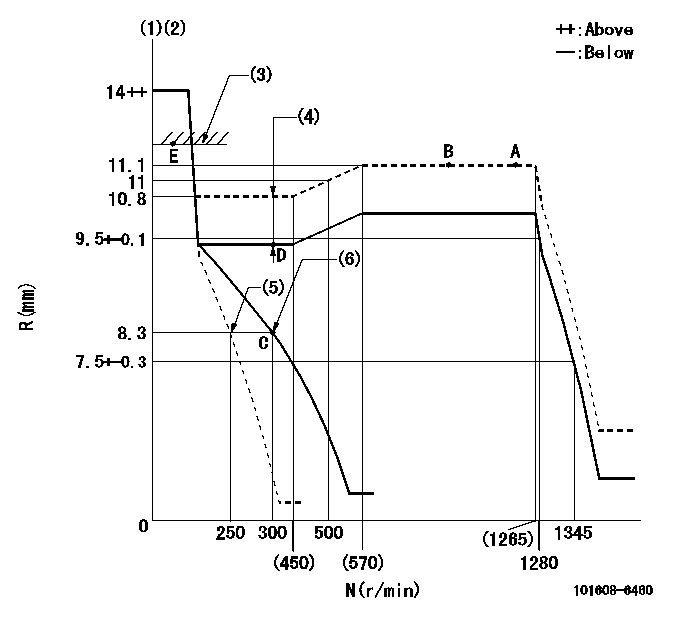
N:Pump speed
R:Rack position (mm)
(1)Target notch: K
(2)Tolerance for racks not indicated: +-0.05mm.
(3)RACK LIMIT
(4)Boost compensator stroke: BCL
(5)Set idle sub-spring
(6)Main spring setting
----------
K=14 BCL=1.1+-0.1mm
----------
----------
K=14 BCL=1.1+-0.1mm
----------
Speed control lever angle

F:Full speed
I:Idle
(1)Stopper bolt setting
----------
----------
a=(26.5deg)+-5deg b=(12.5deg)+-5deg
----------
----------
a=(26.5deg)+-5deg b=(12.5deg)+-5deg
Stop lever angle
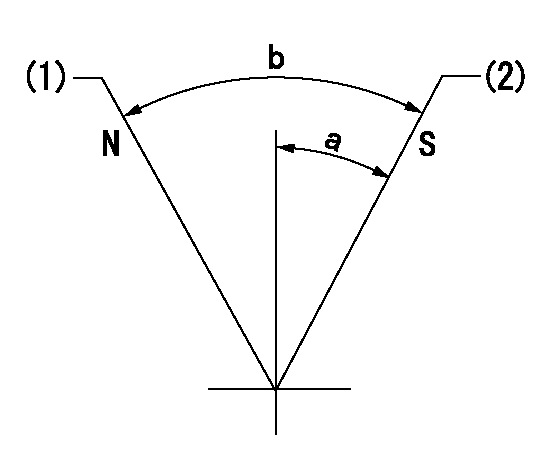
N:Pump normal
S:Stop the pump.
(1)Normal
(2)Pump speed aa and rack position bb (to be sealed at delivery)
----------
aa=0r/min bb=1-0.5mm
----------
a=35deg+-5deg b=(55deg)
----------
aa=0r/min bb=1-0.5mm
----------
a=35deg+-5deg b=(55deg)
0000001501 TAMPER PROOF

Tamperproofing-equipped boost compensator cover installation procedure
(A) After adjusting the boost compensator, tighten the bolts to remove the heads.
(1)Before adjusting the governor and the boost compensator, tighten the screw to the specified torque.
(Tightening torque T = T1 maximum)
(2)After adjusting the governor and the boost compensator, tighten to the specified torque to break off the bolt heads.
(Tightening torque T = T2 maximum)
----------
T1=2.5N-m(0.25kgf-m) T2=2.9~4.4N-m(0.3~0.45kgf-m)
----------
----------
T1=2.5N-m(0.25kgf-m) T2=2.9~4.4N-m(0.3~0.45kgf-m)
----------
Timing setting

(1)Pump vertical direction
(2)Coupling's key groove position at No 1 cylinder's beginning of injection
(3)B.T.D.C.: aa
(4)-
----------
aa=6deg
----------
a=(3deg)
----------
aa=6deg
----------
a=(3deg)
Information:
Preparation for Inspection
Perform the following checks prior to inspection.(1) Make sure the engine oil, air cleaner, starter and battery are normal.(2) Make sure the engine is warm.Inspection
(1) Move the control lever to the top position.(2) Remove all glow plugs, then connect Compression Gauge Adapter (ST333060) and compression gauge to the cylinder whose compression is to be checked.
Compression gauge and adapter(3) Crank the engine using the starter until the needle of the compression gauge stops moving, then read the pressure indication.
Measuring compression pressure(4) If the measurement is lower than the specified limit, perform an overhaul.
(a) Measure the compression pressure of every cylinder. Measuring the compression pressure of two or three cylinders and simply assuming the compression pressures of the other cylinders is dangerous.(b) The compression pressure varies with the engine speed, so it is important to take all measurements with the same engine speed.
2Unit: MPa {kgf/cm} (psi) Take measurements with an engine speed of 240 min-1.
(a) It is important to measure compression pressures regularly and to keep track of changes in them.(b) During the engine's run-in period and after an overhaul, the compression pressures will increase slightly as the piston rings, valve seats, and other parts fit snugly in position. The Pressures will then decrease as parts wear.
Troubleshooting
Overview
Diesel-engine fault symptoms tend to have multiple causes, which influence each other. Consequently, it is often difficult to locate a fault based on the symptoms. Particular care is required when diagnosing faults related to the injection pump, injectors, and compression pressures since such faults may produce the same symptoms.For the above-mentioned reasons, the inspection sequences in the troubleshooting charts on the following pages start with items where the likelihood of a fault is greatest or with items that are easiest to inspect.Owing to their structure and combustion method, diesel engines exhibit the characteristics listed below. Familiarize yourself with these characteristics before performing troubleshooting operations.* Distinctive combustion noise (diesel knock) is emitted during normal operation.* Some black smoke is emitted during high-load operation.* Torque vibration is significant owing to the high compression pressure and high torque.* Slight hunting occurs during rapid deceleration.* Some white smoke is emitted immediately after startup when the engine is cold.
(a) The injection pump cannot be adjusted without a pump tester. Do not attempt to adjust or disassemble the injection pump during troubleshooting operations.(b) To check the combustion conditions in each cylinder, undo the cylinder's injection pipes one at a time (undoing an injection pipe stops injection in that cylinder) and compare the resulting decreases in engine speed. Retighten each injection pipe before undoing the next one.
Difficult Starting
(1) Items to Check
Before performing inspections, check for the following problems:* Clogged air cleaner element* Coagulation of engine oil* Inferior fuel* Low cranking speed(2) Inspection
Knocking
Diesel engines emit a distinctive knocking sound owing to their combustion method. This sound is normal unless it is excessive(1) Items to Check
Before performing inspections, check for the following problems:* Clogged air cleaner element* Inferior fuel(2) Inspection
Overheating
(1) Items to Check
Before performing inspections, check for the following problems:* Low
Perform the following checks prior to inspection.(1) Make sure the engine oil, air cleaner, starter and battery are normal.(2) Make sure the engine is warm.Inspection
(1) Move the control lever to the top position.(2) Remove all glow plugs, then connect Compression Gauge Adapter (ST333060) and compression gauge to the cylinder whose compression is to be checked.
Compression gauge and adapter(3) Crank the engine using the starter until the needle of the compression gauge stops moving, then read the pressure indication.
Measuring compression pressure(4) If the measurement is lower than the specified limit, perform an overhaul.
(a) Measure the compression pressure of every cylinder. Measuring the compression pressure of two or three cylinders and simply assuming the compression pressures of the other cylinders is dangerous.(b) The compression pressure varies with the engine speed, so it is important to take all measurements with the same engine speed.
2Unit: MPa {kgf/cm} (psi) Take measurements with an engine speed of 240 min-1.
(a) It is important to measure compression pressures regularly and to keep track of changes in them.(b) During the engine's run-in period and after an overhaul, the compression pressures will increase slightly as the piston rings, valve seats, and other parts fit snugly in position. The Pressures will then decrease as parts wear.
Troubleshooting
Overview
Diesel-engine fault symptoms tend to have multiple causes, which influence each other. Consequently, it is often difficult to locate a fault based on the symptoms. Particular care is required when diagnosing faults related to the injection pump, injectors, and compression pressures since such faults may produce the same symptoms.For the above-mentioned reasons, the inspection sequences in the troubleshooting charts on the following pages start with items where the likelihood of a fault is greatest or with items that are easiest to inspect.Owing to their structure and combustion method, diesel engines exhibit the characteristics listed below. Familiarize yourself with these characteristics before performing troubleshooting operations.* Distinctive combustion noise (diesel knock) is emitted during normal operation.* Some black smoke is emitted during high-load operation.* Torque vibration is significant owing to the high compression pressure and high torque.* Slight hunting occurs during rapid deceleration.* Some white smoke is emitted immediately after startup when the engine is cold.
(a) The injection pump cannot be adjusted without a pump tester. Do not attempt to adjust or disassemble the injection pump during troubleshooting operations.(b) To check the combustion conditions in each cylinder, undo the cylinder's injection pipes one at a time (undoing an injection pipe stops injection in that cylinder) and compare the resulting decreases in engine speed. Retighten each injection pipe before undoing the next one.
Difficult Starting
(1) Items to Check
Before performing inspections, check for the following problems:* Clogged air cleaner element* Coagulation of engine oil* Inferior fuel* Low cranking speed(2) Inspection
Knocking
Diesel engines emit a distinctive knocking sound owing to their combustion method. This sound is normal unless it is excessive(1) Items to Check
Before performing inspections, check for the following problems:* Clogged air cleaner element* Inferior fuel(2) Inspection
Overheating
(1) Items to Check
Before performing inspections, check for the following problems:* Low
